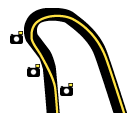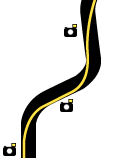Article Topics:
- Overview
- Intro to Racing
- Driving Technique
- Practice Sessions
- Driver’s Gear
- Vehicle Safety
- Handling
- Brakes
- Power
- Tools
TurnFast
recommends
these books:
Articles about Driving Techniques
Cornering
In the end, road racing comes down to cornering. Assuming equal cars, the driver able to sustain the highest speeds through the turns will have the lowest lap times.
To get terminology cleared up first, every corner is made of three parts. We'll call them the entry, the apex, and the exit. The entry is where turning begins. The apex is the point where the car reaches the furthest point on the inside of the turn. The exit is where the car is driving straight again.
The objective in driving through a corner, or a series of corners, is to have the fastest possible speed at the exit of corner, or the last corner of a series. It is not necessarily to have the fastest speed going into the corner, nor even the fastest speed in the middle of the corner. The last corner exit before a straight is the most important segment. The speed of the exit determines the speed during and at the end of the straight. If you can increase the average speed of an entire straight, that will have greater impact that a faster average over the shorter distance of the entry to the turn, or through the turn itself.
The path, or "line" you drive through a corner will determine the exit speed. In general, the fastest line through a corner is the one that allows the greatest radius, or straightest path. As a car can go faster around a large corner than it can around a tight corner, the shortest path around a corner is rarely the fastest.
To illustrate these concepts so far, the classic teaching aid is to look at a 90-degree bend. In the illustration below, the dotted line follows the path of the road. The solid line indicates a path which maximizes the radius of the turn, or attempts to make the turn as straight as possible. As you can see there is significant difference in the tightness of the turn which follows the even the outside of the road compared to one the which utilizes the whole width of the road surface.
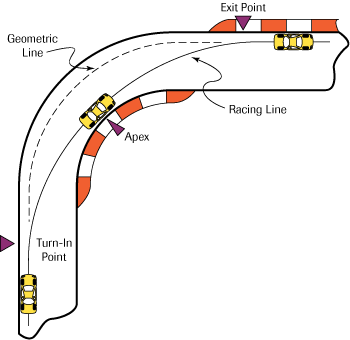
As mentioned, the objective in any corner is to have the highest exit speed. In addition to increasing the corner radius, this also involves taking a line which allows the earliest possible point of getting back into the throttle. To do this, the car must be straightening back out on the corner exit path as early as possible. We can modify the above corner line further to allow this.
The illustration below now shows the previously noted large radius path in the dotted line. The solid colored line shows a path known as the "late apex." This path moves forward the point at which the car reaches the corner apex. The late apex straightens out the exit path of the car, and therefore allows the driver to apply the accelerator earlier. This increases the exit speed, and in effect lengthens the straight which allows for higher speed at the end of the straight.
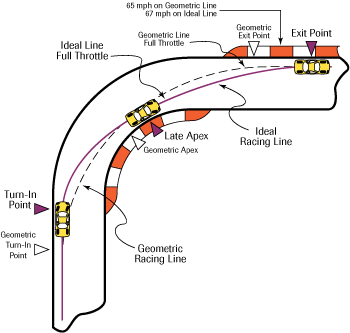
While the geometric racing line is faster than the natural line of the road, there is still a faster technique for most corners. The technique is called using a late apex. By delaying the turn-in point, and beginning the turn with a slightly sharper bend, the car can be aimed to apex later than the geometric apex point. This straightens out the second part of the turn, allowing the driver to apply the accelerator earlier. The car will have to slow down a little more at the turn in phase, but exit speed will be higher. That exit speed gives the driver that much more speed on the straight which will result in lower lap times overall.
This approach works for corners which require hard accelerating cornering out of them, which will be most of them. However, there are many types of corners, and combinations of corners which require some analysis to understand the best approach. Along the right are small figures of corner examples. Click each one to for a larger view and some instructional comments.
Read Next Article (Visual Field)
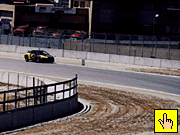
Approach the corner on the edge of the race track to maximize the potential radius. The turn in point for this corner is about one full car length past the brake marker you see in front of the car. By this point, braking should be almost complete and the driver will be easing smoothly off the brakes.
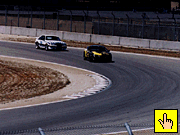
Midway between the turn-in and the apex. Here the driver maintains a constant speed. Using a late apex line, about another two car lengths into the turn from this photo, the driver will begin to accelerate.
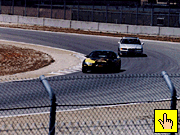
The apex of this corner is slightly late as is the case with most simple corners on the track. The apex is marked by the point the car reaches in inside most position on the track. At this point the driver is almost full on the gas. (Note the second car is very wide, and is not likely to touch the curb marker without slowing down significantly).
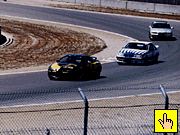
Coming off the apex, the car is now headed for the opposite side of the track. By this point the driver should be at full throttle.
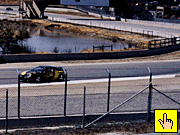
The corner exit should be take as wide as possible. If the corner markers are flat enough, and not excessively slippery, use them as part of the track. However, be careful with tall curbs, they can suck the car up and over them very quickly.
Complex Corner Sets
Not all corners can be taken on the classical racing line. Sets of corners sometimes require a different approach to maximize the exit speed of the last corner. For each illustration below, a track segment will be shown, the fastest line indicated, and some possible lines you might be tempted to believe are better.
